
by Bag It Team | Dec 1, 2019 | Blog
 By Ingrid Jacobs
By Ingrid Jacobs
In February 2010, I picked up my Bag It bag at the Resource Center. I was still in shock with my colon cancer diagnosis and was a little dismissive of this bag and its contents.
When I had some quiet time, I looked through it and sorted out those things that directly affected me. By this time I had accumulated a number of providers’ business cards and other information pamphlets that I had in a pile. I also had copies from various doctors of my personal information. This unorganized collection prompted me to look at the binder more closely. Maybe it had something to offer.
The first thing I noticed in the binder was the clear plastic 10 pocket sheet that is intended for business cards. Yeah, I had plenty of those to fill the front and back of almost every pocket. That stayed right up front in my version of the binder. I often wished that I had a couple of those.
There was the encouraging letter from Sherri Romanoski, the founder of Bag It who had had cancer several years earlier. I think that I appreciate her desire to help more now then when I read her letter back in 2010. There were so many things going through my head at the time of my diagnosis and treatment. There were days I felt crappy. There were days I felt pretty good. I was scared and confused, but through it all, I had an extremely strong determination that kept me focused on what I needed to do. I also had the unwavering support of my daughter, her boyfriend, my 2 cats and a dog, a few cousins, and quite a few friends.
The various tabs in the binder caught my attention: Personal Information, Notes/Log/Calendar, Reports/Scans, Labs, and After Treatment. I had something for just about every tab. Hmmmm. . . not half bad. Somebody had put some real thought into this goody binder. I soon found myself putting papers behind the corresponding tabs. Then, I started to personalize it to fit my needs. I created my own tabs. Now I have my dated Chemo Logs and my Post-Chemo Logs. In between my chemo sessions I kept a log of what I was noticing, what I was doing to help myself, and questions I wanted to ask. Every two weeks, I took a copy of this log to my doctor to put into my file. She said that it was very helpful for her to read about these things because it actually helped her with my treatment plan.
 Eventually, my original binder was bursting at the seams. I bought a second binder and created my own matching covers for both binders. I labeled them Arizona Oncology Logs and Labs #1 and #2. I know . . . clever and original. (giggle)
Eventually, my original binder was bursting at the seams. I bought a second binder and created my own matching covers for both binders. I labeled them Arizona Oncology Logs and Labs #1 and #2. I know . . . clever and original. (giggle)
From my doctor, I learned that diet (including vitamins and supplements) was very important for more positive treatment results. I created a 3rd binder with corresponding information. That’s a whole other part of the continuing saga of me taking better charge of my health.

by Annettra Farrington | Aug 15, 2019 | Educational Articles
None of us have as much time as we’d like when we see the oncologist, primary care physician, or any member of our healthcare team. Maximize those precious few minutes and make the most of your visits with these hacks:
Before you go:
-
- Prepare for the appointment at least a few days in advance. Complete any online research you want to do (Our Resource Center has reliable cancer websites).
- Use My Appointment Summary Log (found in My Companion Guidebook)
 to organize what you need to bring and discuss, where and when you are going.
to organize what you need to bring and discuss, where and when you are going.- Write down your questions (use the small journal or sheets provided).
- Leave room to write down the answers you are given.
- Prioritize your top 3 questions to ask the doctor. (Other members of the healthcare team can answer or obtain answers for the other questions for you).
” I still use the bag…it is a Godsend, I am always using it. It has taught me to always take notes, whenever I have a question for ANY doctor I write the question and answer down. I use it as a reference for dates and other information regarding any of my medical history.”
At the visit:
- Bring someone with you. Let them know how they can help you: extra set of ears, take notes, give info you may have forgotten.
- Good communication with your healthcare team is key! Click here for tips
- Consider recording the visit (ask permission first) to replay it at a later time.

- Bring your Bag It My Companion Guidebook or appropriate pieces within to refer to questions, forms and logs you prepared. Write down the answers and other info given to you so you don’t have to try to remember it.
- Ask for copies of your reports, labs, information from the visit. Add them to your notebook.
Click below for questions to ask your healthcare team from Paths to Survivorship booklet.
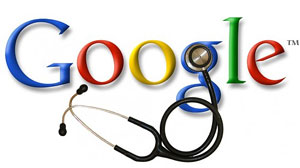
by Annettra Farrington | May 28, 2019 | Educational Articles
Is there a doctor (Google) in the house?
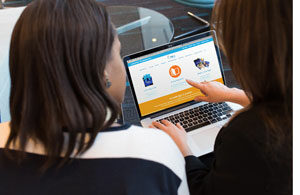 Most of us immediately want to search online when facing a cancer diagnosis. The internet can be a good source of reliable and helpful information. At the same time, unfortunately, fake medical news and misinformation spreads further than the truth – and can lead to serious consequences.
Most of us immediately want to search online when facing a cancer diagnosis. The internet can be a good source of reliable and helpful information. At the same time, unfortunately, fake medical news and misinformation spreads further than the truth – and can lead to serious consequences.
Best Practices for Internet Research:
- First ask your health care team for trusted websites they recommend for you.
- Visit Bag It’s resource center to find over 150 resources on all cancer topics.
- Websites from these organizations are generally reliable:
- Government agencies (web address ends .gov)
- Major cancer centers (web address often ends .org)
- Medical schools and universities (web address ends .edu)
- Large nonprofit organizations (web address ends .org)
- Look for easy-to-read information written by medical professionals.
- Check more than one source for the same information to verify that the results are the same.
Things to consider when evaluating a website:
- Be critical – is the content objective and free of opinion?
- Who sponsors the site and its content? Who wrote the content and what are their credentials? Who approved it? Reading the “About Us” and “Who We Are” pages can be insightful.
- What is the source of the information presented? Particularly if scientific in nature, was the content written within the last three years and is it supported by the scientific literature?
- Be aware that information on sponsored websites or .com websites may be biased or have a conflict of interest, though the information could still be reliable (such as a drug company’s site)
- Think carefully before sharing personal/health information in online communities. Does the community safeguard your privacy? Refer to the privacy policy, if any.
Remember that the internet is not a substitute for professional medical care and advice. Discuss any information you find with your health care team to help you determine if it is right for you.

by Bag It Team | May 20, 2019 | Blog
By Friend of Bag It
Recently, my older widowed neighbor was diagnosed with cancer. She was shocked by her diagnosis and knew nothing about cancer because “no one in the family had cancer.” I offered to accompany her on her upcoming appointments as another pair of ears and a scribe. This began a journey where I learned, first-hand, how hard it is to manage this diagnosis, and how incredibly important the right tools and the right information can be. I knew how her soon-to-be-received bag could help Mary and her family through this difficult time, and that put a smile on my face. The solid cancer information found in the printed pubs and reliable cancer websites found in the resources section of the binder and Bag It’s website will help them navigate during and after treatment.

On appointment day we had to arrive 30 minutes early for Mary to deal with the sheaf of paperwork that greeted her. Her cancer pain visible on her face, it was a struggle for Mary to fill out her extensive medical history from memory. While Mary had received a full printed list of her meds from her smart PCP, she could not find it in her wallet. As I sat there watching her try to recall all the names and doses of the meds she took, I visualized how much easier and less stressful it would have been for Mary if she could have just copied all of her personal medical information from the pre-filled forms in her Bag It binder onto the provider’s forms. 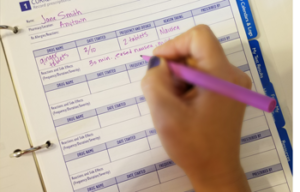 Ten minutes tops. As it turned out the forms were incomplete when we were called into the exam room 45 minutes later. The MA filled in some of the gaps. The kind doctor confirmed the cancer diagnosis, specifying the location, stage and grade of the tumor. It was described as an “aggressive” cancer, and surgery was necessary. A sentinel node biopsy would determine the extent of the surgery. The need for chemotherapy and/or radiation would be known after the full pathology results were in. The doctor spoke in a straightforward manner that provided the basic facts without much elaboration. Things moved quickly as surgery timing and next steps were discussed. Mary posed one or two questions about post-op home care needs but nothing about her cancer or treatment – she didn’t know what to ask.
Ten minutes tops. As it turned out the forms were incomplete when we were called into the exam room 45 minutes later. The MA filled in some of the gaps. The kind doctor confirmed the cancer diagnosis, specifying the location, stage and grade of the tumor. It was described as an “aggressive” cancer, and surgery was necessary. A sentinel node biopsy would determine the extent of the surgery. The need for chemotherapy and/or radiation would be known after the full pathology results were in. The doctor spoke in a straightforward manner that provided the basic facts without much elaboration. Things moved quickly as surgery timing and next steps were discussed. Mary posed one or two questions about post-op home care needs but nothing about her cancer or treatment – she didn’t know what to ask.
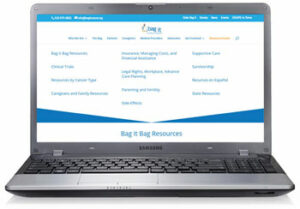 Since then, I think about all the ways Mary could have benefited from receiving a Bag It bag at the initial time of diagnosis or during this early appointment. From the forms, calendars and glossary of basic cancer terms in the navigation binder to the printed pubs with tips on how to prepare for appointments/questions to ask about diagnosis/treatment, ways for patients and families to cope with their diagnosis, how to be an active member of their health care team, and so much more. The Bag It resource center on the website offers more than 150 reliable sites for patients and their families to find credible information and resources right when they need it. Topics include cancer types, clinical trials, side effects, supportive care/emotional support, caregivers and family resources, insurance, and financial assistance, legal rights, advance care planning, and survivorship. Check it out These advantages also serve the healthcare team as Mary would have the tools and knowledge to be more prepared, organized, and better informed. By using her Bag It bag Mary would ideally take a more active role in advocating for herself and likely improve her quality of life as a result. The early window of opportunity to provide a Bag It bag can easily be missed for a variety of reasons but remember it is helpful at any point in the continuum of care and for any type of cancer.
Since then, I think about all the ways Mary could have benefited from receiving a Bag It bag at the initial time of diagnosis or during this early appointment. From the forms, calendars and glossary of basic cancer terms in the navigation binder to the printed pubs with tips on how to prepare for appointments/questions to ask about diagnosis/treatment, ways for patients and families to cope with their diagnosis, how to be an active member of their health care team, and so much more. The Bag It resource center on the website offers more than 150 reliable sites for patients and their families to find credible information and resources right when they need it. Topics include cancer types, clinical trials, side effects, supportive care/emotional support, caregivers and family resources, insurance, and financial assistance, legal rights, advance care planning, and survivorship. Check it out These advantages also serve the healthcare team as Mary would have the tools and knowledge to be more prepared, organized, and better informed. By using her Bag It bag Mary would ideally take a more active role in advocating for herself and likely improve her quality of life as a result. The early window of opportunity to provide a Bag It bag can easily be missed for a variety of reasons but remember it is helpful at any point in the continuum of care and for any type of cancer.

by Annettra Farrington | Apr 16, 2019 | Educational Articles
What is Self-Advocacy and why is it important?
 Self-advocacy is taking a proactive approach to being part of your healthcare team to ensure your needs are met and you are more in control to live your best life possible with cancer. It includes learning how to educate yourself with reliable information, knowing your rights, listening, and asking the right questions to make sound decisions. Being able to clearly communicate with others and feeling comfortable in making yourself heard are important. Reaching out to others when you need help is another form of self-advocacy and self-respect.
Self-advocacy is taking a proactive approach to being part of your healthcare team to ensure your needs are met and you are more in control to live your best life possible with cancer. It includes learning how to educate yourself with reliable information, knowing your rights, listening, and asking the right questions to make sound decisions. Being able to clearly communicate with others and feeling comfortable in making yourself heard are important. Reaching out to others when you need help is another form of self-advocacy and self-respect.
Bag It’s NEW publication Paths to Survivorship and other contents in your bag guide you on how to advocate for yourself from the moment of diagnosis and beyond.
How to Advocate for Yourself:
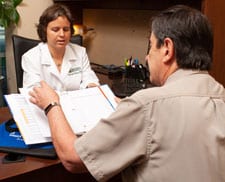
- Use your Bag It My Companion Guidebook to organize and track your own information. It’s a handy reference and a good back up if something gets lost. Request copies of your records, labs and test results at every appointment. Store them in the 3-ring guidebook with the most recent on top.
- Write down your questions before your appointment and then write down the answers.
- Bring someone with you to every appointment. A second pair of ears is helpful. They can take notes or record what’s said (ask permission first).
- Visit only reliable websites for cancer information. See Bag It’s resource page for more than 150 websites.
Resource topics include:
- Types of Cancer
- Clinical Trials
- Side-Effects
- Survivorship
- Caregivers and Family Resources
- Parenting and Fertility
- Supportive Care—Emotional Support, Palliative Care, Complementary & Integrative Therapies
- Insurance, Managing Costs, and Financial Assistance
- Legal Rights, Workplace, Advance Care Planning
- Resources in Spanish
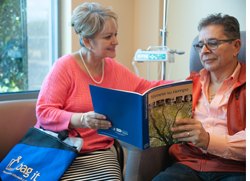 If you were recently diagnosed:
If you were recently diagnosed:
- Assemble and work closely with all the members of your healthcare team.
- Learn about your cancer diagnosis and treatment options with potential side effects to help you make informed decisions about your treatment and care. Consider getting a second opinion.
- Use the My Appointments Summary Log found in My Companion Guidebook to write down your questions in advance of appointments. Make sure you fully understand the answers provided and take notes.
- Bring someone with you to every appointment, especially at the beginning.
- Express fully and honestly what you need and want—to your healthcare team, caregivers, family members, and friends.
- Watch our short “How to use the Bag It bag” video.

 By Ingrid Jacobs
By Ingrid Jacobs Eventually, my original binder was bursting at the seams. I bought a second binder and created my own matching covers for both binders. I labeled them Arizona Oncology Logs and Labs #1 and #2. I know . . . clever and original. (giggle)
Eventually, my original binder was bursting at the seams. I bought a second binder and created my own matching covers for both binders. I labeled them Arizona Oncology Logs and Labs #1 and #2. I know . . . clever and original. (giggle)

 to organize what you need to bring and discuss, where and when you are going.
to organize what you need to bring and discuss, where and when you are going.

 Most of us immediately want to search online when facing a cancer diagnosis. The internet can be a good source of reliable and helpful information. At the same time, unfortunately, fake medical news and misinformation spreads further than the truth – and can lead to serious consequences.
Most of us immediately want to search online when facing a cancer diagnosis. The internet can be a good source of reliable and helpful information. At the same time, unfortunately, fake medical news and misinformation spreads further than the truth – and can lead to serious consequences.

 Ten minutes tops. As it turned out the forms were incomplete when we were called into the exam room 45 minutes later. The MA filled in some of the gaps. The kind doctor confirmed the cancer diagnosis, specifying the location, stage and grade of the tumor. It was described as an “aggressive” cancer, and surgery was necessary. A sentinel node biopsy would determine the extent of the surgery. The need for chemotherapy and/or radiation would be known after the full pathology results were in. The doctor spoke in a straightforward manner that provided the basic facts without much elaboration. Things moved quickly as surgery timing and next steps were discussed. Mary posed one or two questions about post-op home care needs but nothing about her cancer or treatment – she didn’t know what to ask.
Ten minutes tops. As it turned out the forms were incomplete when we were called into the exam room 45 minutes later. The MA filled in some of the gaps. The kind doctor confirmed the cancer diagnosis, specifying the location, stage and grade of the tumor. It was described as an “aggressive” cancer, and surgery was necessary. A sentinel node biopsy would determine the extent of the surgery. The need for chemotherapy and/or radiation would be known after the full pathology results were in. The doctor spoke in a straightforward manner that provided the basic facts without much elaboration. Things moved quickly as surgery timing and next steps were discussed. Mary posed one or two questions about post-op home care needs but nothing about her cancer or treatment – she didn’t know what to ask. Since then, I think about all the ways Mary could have benefited from receiving a Bag It bag at the initial time of diagnosis or during this early appointment. From the forms, calendars and glossary of basic cancer terms in the navigation binder to the printed pubs with tips on how to prepare for appointments/questions to ask about diagnosis/treatment, ways for patients and families to cope with their diagnosis, how to be an active member of their health care team, and so much more. The Bag It resource center on the website offers more than 150 reliable sites for patients and their families to find credible information and resources right when they need it. Topics include cancer types, clinical trials, side effects, supportive care/emotional support, caregivers and family resources, insurance, and financial assistance, legal rights, advance care planning, and survivorship.
Since then, I think about all the ways Mary could have benefited from receiving a Bag It bag at the initial time of diagnosis or during this early appointment. From the forms, calendars and glossary of basic cancer terms in the navigation binder to the printed pubs with tips on how to prepare for appointments/questions to ask about diagnosis/treatment, ways for patients and families to cope with their diagnosis, how to be an active member of their health care team, and so much more. The Bag It resource center on the website offers more than 150 reliable sites for patients and their families to find credible information and resources right when they need it. Topics include cancer types, clinical trials, side effects, supportive care/emotional support, caregivers and family resources, insurance, and financial assistance, legal rights, advance care planning, and survivorship. 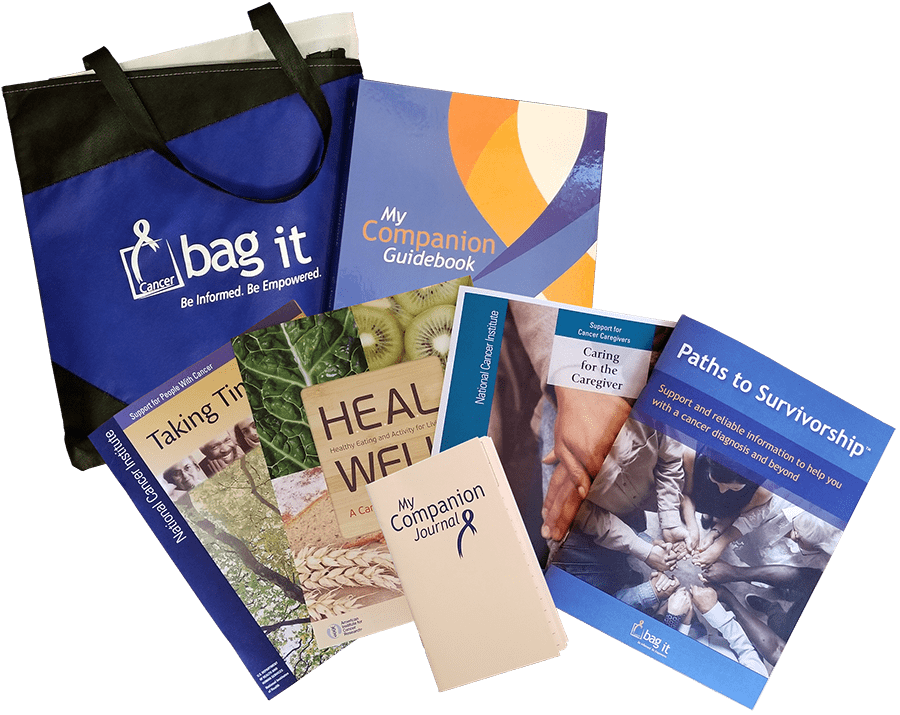

 Self-advocacy is taking a proactive approach to being part of your healthcare team to ensure your needs are met and you are more in control to live your best life possible with cancer. It includes learning how to educate yourself with reliable information, knowing your rights, listening, and asking the right questions to make sound decisions. Being able to clearly communicate with others and feeling comfortable in making yourself heard are important. Reaching out to others when you need help is another form of self-advocacy and self-respect.
Self-advocacy is taking a proactive approach to being part of your healthcare team to ensure your needs are met and you are more in control to live your best life possible with cancer. It includes learning how to educate yourself with reliable information, knowing your rights, listening, and asking the right questions to make sound decisions. Being able to clearly communicate with others and feeling comfortable in making yourself heard are important. Reaching out to others when you need help is another form of self-advocacy and self-respect.
 If you were recently diagnosed:
If you were recently diagnosed:
Recent Comments